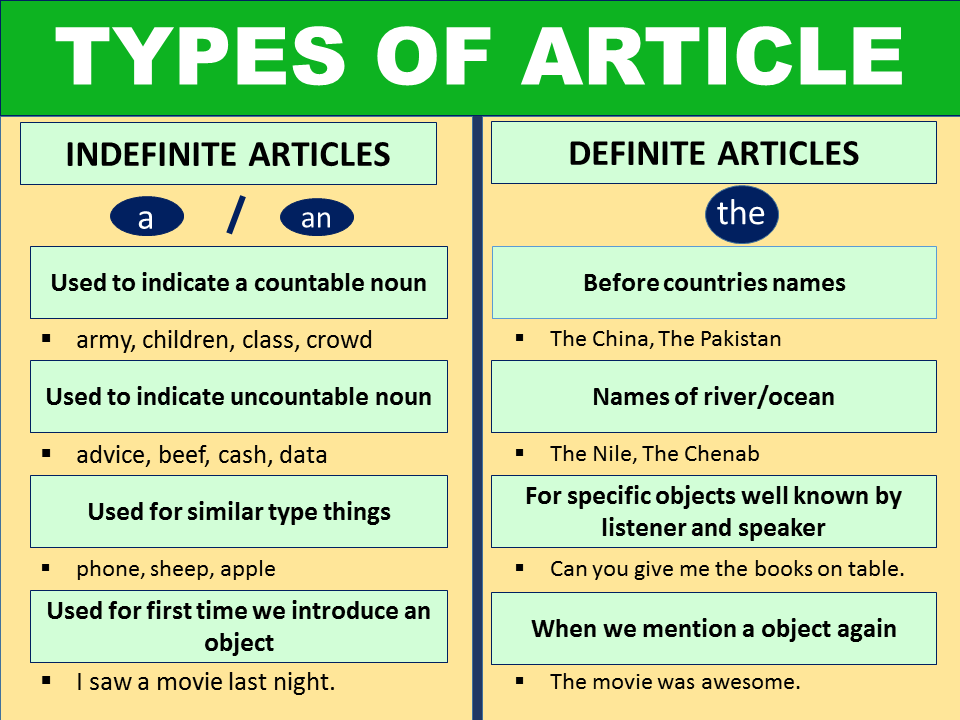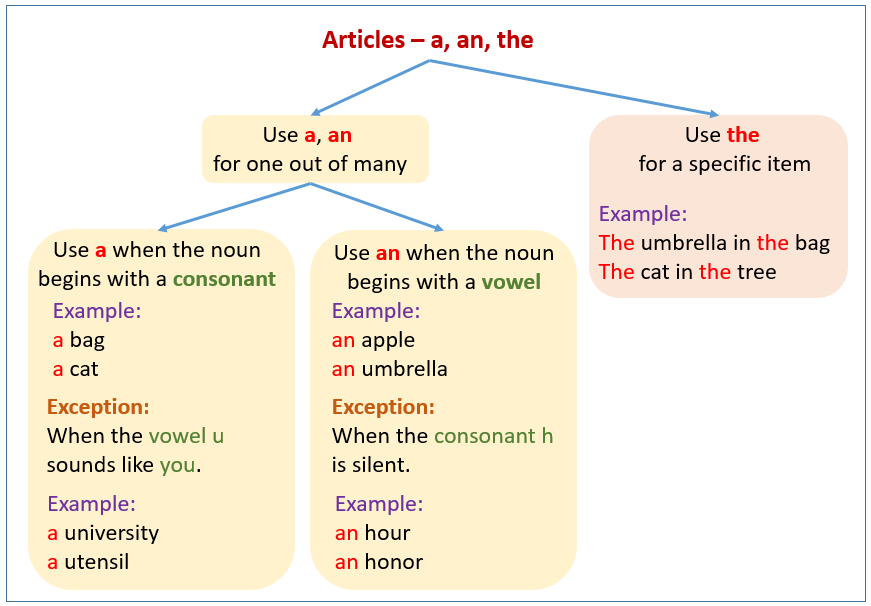What is an Article?
An article is a short monosyllabic word that is used to define if the noun is specific or not. Articles are normally used before nouns and since they are used to speak about the noun, they can be considered as adjectives.
Look at how various dictionaries define an article to have a much clearer idea of what they are.
Definition of an Article
An article, according to the Merriam-Webster Dictionary, is defined as “any of a small set of words or affixes (such as a, an, and the) used with nouns to limit or give definiteness to the application.” According to the Collins Dictionary, “an article is a kind of determiner. In English, ‘a’ and ‘an’ are called the indefinite article, and ‘the’ is called the definite article.” The Macmillan Dictionary defines an article as “a type of determiner (=word used before a noun) that shows whether you are referring to a particular thing or to a general example of something. The indefinite article is ‘a’ or ‘an’ and the definite article is ‘the’.”
Types of Articles
There are three articles in English – ‘a’, ‘an’ and ‘the’. These articles are divided into two types namely:
- Definite Article
- Indefinite Article

Definite Article
Among the three articles, ‘the’ is said to be the definite article. A definite article is used to determine something that is specific or particular. It is also used before plural nouns and to indicate the superlative degree of comparison. Furthermore, it can be used before collective nouns as well.
For example:
- The Sun sets in the west.
In the above sentence, the nouns ‘Sun’ and ‘west’ are proper nouns and are specific and so the definite article has to be used.
- The children are playing cricket.
In the above sentence, the definite article is used to determine the plural noun, ‘children’.
- This is the world’s longest river.
In the above sentence, the definite article is used to denote the superlative degree of comparison.
- The crowd sang along with the band.
In the above sentence, the definite article is used before the collective nouns, ‘crowd’ and ‘band’.
Indefinite Article
The articles ‘an’ and ‘an’ are termed as indefinite articles. An indefinite article, as the name suggests, is used to indicate something that is not definite or specific. It can also be used before singular nouns.
Among the indefinite articles, ‘an’ is used before singular nouns that start with vowel sounds and ‘a’ is used before singular nouns that begin with consonant sounds.
For example:
- I had an apple for breakfast.
- Do you have an eraser?
- I saw an aeroplane.
- She has a pet dog.
- My father is a doctor.
- My brother gave me a calculator.
Usage and Exceptions – Points to be Remembered When Using Articles
Articles are used extensively by English language users, and for this very reason, it is important to know where and where not to use them. In order to have a thorough knowledge of how to use the right articles in the right places, have a look at the following.
A or An?
The article ‘an’ is normally used before words that begin with vowel sounds. However, this is often confused with the idea that it can be used before words that start with a vowel. Look at the examples given below to understand how this works.
-
- I have an umbrella.
- This is an orange.
- An elephant was crossing the road.
If you see here, the words ‘university’ and ‘unique’ start with a vowel. However, it does not have a vowel sound but a consonant sound ‘yu’ in the beginning. It is because of this reason that the indefinite article, ‘a’ is used instead of ‘an’.
-
- Studying in a university will give you a lot of exposure.
- This is a unique way of communicating with birds.
In the examples given below, ‘an’ is used before ‘MBA’ and ‘hour’ though they are words starting with consonants. This is because the word ‘MBA’ starts with ‘m’ which has a vowel sound (em) in the beginning. Likewise, the ‘h’ in the word ‘hour’ is silent, thus having a vowel sound in the beginning.
-
- I have completed an MBA degree.
- It took an hour to reach the airport.
Examples of Articles
Let us look at a few more examples to find out how articles can be used.
- The English teacher is absent today.
- I saw a bird sitting on the tree in front of my house.
- Not many know how to use an oven properly.
- Tom has a cat.
- We are going to buy a dress for our daughter.
- Carry an umbrella. I am sure it will rain.
- Keren found a puppy on the road.
- The parents have been asked to attend a meeting tomorrow.
- The committee has decided to bring down the fuel rates.
- Due to a hartal, the shops have been closed.
Check Your Understanding of Articles
Fill in the blanks with the appropriate articles in the following sentences:
1. Have you watched ______ new movie?
2. I have never used ______ computer.
3. Do you know _____ multiplication tables?
4. Sandra brought ______ apple.
5. Madhu has ____ teddy bear.
6. ______ chairs are all broken.
7. The janitor asked ______ students to walk carefully as ______ floor was wet.
8. I have finished reading _____ book you lent me.
9. Hari is planning to buy ____ new car.
10. He has been waiting for ___ hour.
